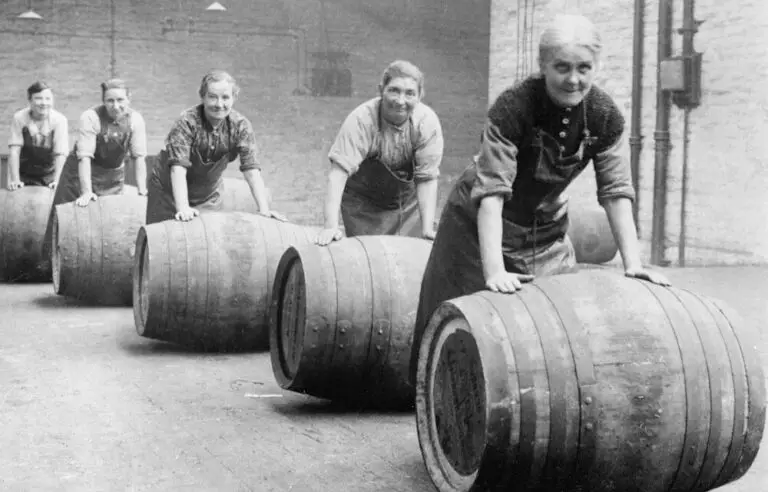Is Beer High In Calcium?
Beer is everywhere. It’s the third most commonly consumed drink by humans (right after water and tea) and the most widely consumed alcoholic drink in the world. Yes, beer is more popular than coffee, than any type of soft drink, and than wine. Beer, in one shape or another, is available in virtually every corner of the world (in some countries where alcohol is illegal, non-alcoholic beer is very popular).
Follow us on Instagram!
Beer has a very complex chemical profile. It’s an incredible combination of more than 3,000 chemical compounds, all floating in a pool of water. Among these chemical compounds, the most important inorganic ones are sodium, magnesium, sulfur, calcium, chloride, and potassium. All have important roles in how the beer looks, tastes, how long it lasts, and even how much froth it makes.

Let’s talk about calcium in beer. What’s calcium’s role in brewing? Why is calcium important during the fermentation process? Let’s have an in-depth talk about calcium in beer:
Is Beer High In Calcium? How Much Calcium Is In Beer?
The short answer you probably are looking for is – yes, beer has calcium. How much? Usually, most calcium levels are 30 to 150 ppm, depending on the beer type.
- light beer: 5 to 10 mg per 12-ounce serving
- lagers: 10 to 15 mg per 12-ounce serving
- stout and other dark beers: 20 to 25 mg per 12-ounce serving
Now, let’s delve deeper… because there is more, a lot more about calcium:
Calcium Lowers pH Levels During Beer Fermentation
Calcium has a very diverse role in brewing. Calcium is crucially important during the initial fermentation phase when it reduces the pH levels (phosphates react with calcium and release hydrogen ions that reduce pH levels). This is important when brewing lagers, which are brewed at a lower pH level (if the pH level is too high, the resulting beer is no longer considered a good lager). However, larger amounts of calcium are also used when brewing IPAs.
Calcium Increases Mash Acidity
Calcium interacts with phosphates and polypeptides in the mash, reducing the pH levels. Lower mash pH levels (with pH levels around 5.0, the mash is considered acidic) help the development and growth of various enzymes that promote fermentation, like alpha-amylase, beta-amylase, and proteolytic enzymes. These enzymes eat the starch in malt and turn it into soluble sugars (carbs). To produce a thick, dark, rich beer, you will have to use more alpha-amylase enzymes.
Lower pH levels make the mash and wort acidic, increasing the activity of enzymes. For instance, the pH level should hover around 4.7 for optimal beta-amylase enzyme activity. If beta-amylase enzymes are more active, the fermentation process is quicker, and the production of maltose is higher, creating a better quality beer.
Calcium also helps the development of alpha-amylase enzymes. Their activity is high at about 65 to 68 Celsius (149 to 155 Fahrenheit), but it is very unstable. Calcium makes the alpha-amylase enzyme activity much more stable at 70 to 75 Celsius (158 to 167 Fahrenheit).
The drop in pH caused by calcium ions in the mash increases beer’s shelf life. The beer is essentially made at a greater microbiological resistance, making it last longer and resist possible infections. So this means that calcium stops beer from going bad.
High calcium levels make mash more acidic, which is particularly important if the brewing water is alkaline. This is why brewers who live in areas with soft water (low in calcium and magnesium) add calcium to the mash to increase its acidity and promote enzyme development.

Calcium Promotes The Degradation Of Proteins
Calcium also promotes the precipitation of wort proteins during the boiling and fermentation process. Proteins are also degraded in the presence of calcium. They are converted into simpler substances by various proteolytic enzymes (proteases) found in malt, especially at pH levels of 4.5 to 5.0. The degradation of protein levels increases wort Free Amino Nitrogen levels (FAN).
Proteins must be degraded during fermentation because too much protein is bad for most beer styles. Too many proteins make the beer hazy, unclear, and difficult to filtrate. It also reduces the beer’s shelf life, especially for lighter types of beers, like lagers. Calcium also promotes the flocculation of yeasts during the fermentation process.
Quick fact: Yeast flocculation – the tendency of yeast cells to aggregate in a group, forming a unitary multicellular mass, which tends to sediment rapidly or rise to the surface. Flocculation occurs near the end of the fermentation process, and brewers closely monitor it.
Calcium Provides Structure
Calcium makes beer taste complete, round, and firm. Brewers often say that calcium provides structure to the beer. It makes beer taste complete, round, and firm. Average levels of calcium hover from 30 ppm to more than 150 ppm, depending on the type of beer.
- beers with low calcium levels, under 50 ppm – the beer seems soft, bland, and undistinctive
- beers with moderate calcium levels, from 50 to 100 ppm – the beer is properly structured, well-rounded, and complete
- beers with high and very high calcium levels, more than 150 ppm – these beers are crisp, firm, hard, strong, and dense; typically, levels above 150 ppm are present in IPAs and dark beers
- beers with very high levels of calcium, over 300 ppm, are too bitter and can upset the balance of the finished beer and the magnesium uptake
Calcium Reduces Haze
Calcium and magnesium contribute to the beer’s clarity and stability. It makes the beer look clean, crisp, and stable. It also makes wort have a lighter color, and it extracts hop bitterness. Adding too much hops during the early phases of beer fermentation makes the beer bitter.
Reverse Osmosis Water To Get More Calcium
Many modern brewers use reverse osmosis systems (R/O systems) to get better water for their brewing process. The reverse osmosis water definitely tastes better and is good for brewing, but some brewers noticed that the beer is less complex and less bright than usual. If this is the case, the calcium levels in the reverse osmosis water are too low. To counteract this, you have to add calcium to your water.

Beer Brewing Salts To Increase Calcium Levels
There are three types of calcium additives (brewing salts) used in brewing:
- calcium sulfate (also known as gypsum) – a great additive for hoppy beers but not ideal for malty or delicate beers; if your water is high in chloride, use calcium sulfate; gypsum enhances bitterness, it makes a beer a little dryer than usual, so use it for IPAs or lagers
- calcium chloride – a less noticeable alternative to gypsum; if your water in sulfate, use calcium chloride; it enhances maltiness, so use it more in brown or amber beer
- calcium carbonate – it makes beer less acidic, so it is ideal for dark beers, like stout; it’s useful if you want to counter the acidity caused by darker grains
Most brewers use a blend of these two to combine their effects and create a better-tasting beer with a more complex set of flavors. Another
Quick fact: Calcium is more important for lighter beers, like lagers. It reduces the pH level, which is important when brewing lagers.
Can Beer Be A Source of Calcium?
No. While beer has calcium in it, which is critical during brewing, it’s not enough for your dietary needs. Beer has trace amounts of calcium, so you should not drink beer for its calcium content. Try other sources of calcium instead, like leafy greens, tofu, milk, and other dairy products.
Can Beer Interfere With Natural Calcium Absorption?
Yes, beer, like all alcoholic beverages, can interfere with natural calcium absorption. Talk to your doctor if you need more information about this or if you need calcium supplements.
Wrapping it up
Calcium is the most important mineral in brewing. It promotes yeast flocculation and protein degradation; it reduces mash acidity, promotes enzyme growth, and improves beer taste. Calcium is the mineral that makes beer the excellent drink we all love!

I am a young architect with a passion that goes beyond blueprints… it’s beer! undertherosebrewing.com is more than just a blog, it’s a manifestation of my lifelong dream to explore, read, and learn everything about beer. Join the blog on this unfiltered and genuine adventure into the heart of beer culture. Cheers!






